Medlar trees, also known as common Medlar, are part of the rose family Rosaceae and the Medlar fruit has been grown since Roman times.
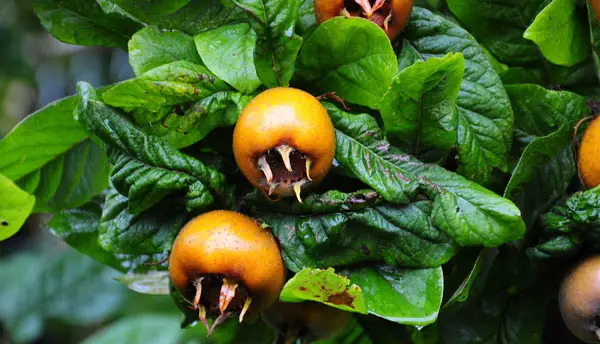
Jump To...
About Medlar Trees
You can be forgiven for not knowing what medlar fruit looks like – you may never have heard of it. It’s a fruit most definitely not to everyone’s tastes and is not often enjoyed fresh.
Having said this, they are hardy plants that aren’t at risk of frost due to their late flowering. This makes them popular in gardens and the fruit makes delicious jams and jellies.
Medlar Blossom & Fruiting
Medlar trees do not flower until late in the season but when they do they fetaure lovely white striking flowers.
The trees don’t fruit until late summer and fruit isn’t edible until late October or early November. This has its advantages though as it means you don’t need to worry about frost damage. Medlars need little watering so if you are looking for a low maintenance tree then you might get on well with one of these. They can reach an impressive height of 8 metres
How To Grow Medlar Trees
Medlars are extremely hardy trees, and are well suited to the UK climate having been a popular UK fruit for well over 600 years. They tolerate frost well, and can survive temperatures far below those that the British climate would usually see. That said, they do need care to thrive, so here’s our guide on how to grow medlar trees for optimal fruit production.
When To Plant Medlars
You can technically plant a medlar tree any time of the year, including winter – it’s best to aim between November and March. You should ensure the ground is not frozen at the time of planting so the tree roots are not damaged. The tree can survive it’s first growing season in a pot if need be, you just have to ensure it is well watered.
Where To Plant Medlars
These trees are hardy but they do need a degree of shelter because high winds can cause damage to their leaves and flowers. They prefer a spot with plenty of sunshine and light but can grow well with some shade too. Medlar trees are tolerant of most soil types but do best in deep soil that is fertile and has good drainage. These trees are usually grown on either quince or hawthorn rootstock so you do need to have a fairly large space available. It’s advisable to support your tree with stakes during its first 3-4 years of life.
If you don’t have a lot of space to grow your medlar crop, why not try out a dwarf medlar tree? These new varieties mean that small spaces can now produce this interesting and ancient fruit.
How To Prune Medlar Trees
Pruning is essential to the tree’s crop and overall health so it’s important to not neglect this task. During its first three or four years of life, you’ll notice the branches don’t grow straight which makes the tree look unique and full of character. However, it’s important to not allow overcrowding to occur too much as it stops light from getting in which will affect healthy growth.
Pruning should start when the tree is young to encourage a healthy shape as it grows. During the winter, tend to the longest branches by cutting them back by about a third. When cutting, be sure to make the snip back to an outward-facing bud. Any short roots can be left alone to encourage a healthy display of flowering. Once the tree matures and is well-established, pruning won’t have to be so regular.
When To Harvest Medlar Fruit
You won’t get your hands on medlar fruit until October, perhaps November time despite the fruit appearing late summer. It isn’t edible until it’s very soft and it very much has the texture of a stewed apple. Once it’s been picked you should actually store them for 2 to 3 weeks before eating.
Many people refer to it as a rotting fruit, which perhaps attributes to needing an acquired taste to enjoy it. It’s not wise to leave them until they fall from the tree as by this point they may be too mushy.
If you don’t have a very large garden, you can also get a patio medlar tree and grow this heritage fruit in a pot!
FAQ’s
Medlar trees are lovely to look at and grow to an impressive size too. If you are still not sure exactly what is what, take a peek at our FAQS section.
A medlar tree can grow as high as 8 metres so you must have the space available in your garden. For a smaller tree, you can have it grafted on either quince or hawthorn rootstock. These dwarf versions will grow to around 3 or 4 metres – much more suitable to most UK gardens.
You can expect to see fruit growing on your medlar tree when it’s 3 to 4 years old, and it will reach its full crop potential once it’s 5 to 6 years old.
Medlar trees are self pollinating which is great due to the size just one could take up. You’d need quite a bit of space to plant two, with a wide space between them and other plants.
Medlar pips should be pretreated before sowing to allow for the best results. Pips should be soaked for 48 hours first and then plant into some moist compost that isn’t too wet. Seeds and the compost can be popped into a plastic bag, loosely tied to allow for air circulation. They can then be popped into the fridge for 52 weeks and then warmed up for a further 36 weeks on a sunny spot. After this, another cold treatment is required and during this period of around 17 weeks, the seeds should germinate. At this point, they can be planted outdoors.
Medlar fruit is good as jam or jelly but also has some health benefits. It can aid in constipation issues and can also help bladder and kidney stones on their way. It can help with stomach issues such as bloating too – worth a try for IBS sufferers.
Medlar fruit is very similar to apple purée or stewed apple in texture and can be enjoyed fresh this way. It can also be enjoyed alongside wine and cheese – yes, please! Once it’s blotted, medlar fruit is sweet but with a hint of acidity too.
Medlar trees grow successfully in Scotland due to their hardy nature against the cold weather. They do better with a sheltered location to protect them from those famous Scottish gales.

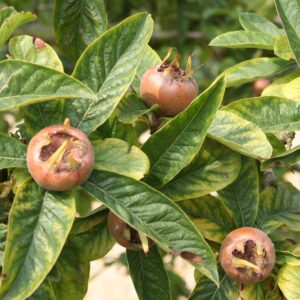

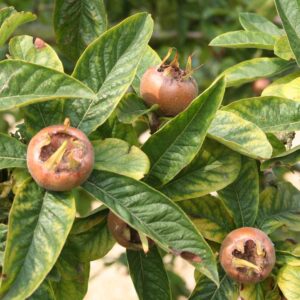
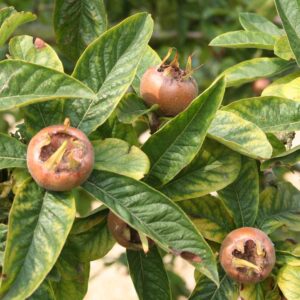
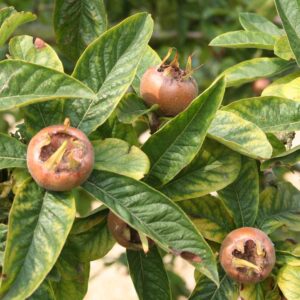


What is the best time of year in UK to prune medlar trees. I need to cut two whole branches off that are obstrucing a garden , can I take these off without shocking or killing the tree.
Thank you
Hello Rod, Medlars are best pruned towards the end of winter when they are coming towards the end of their period of dormancy. That tends to be late February / Early March. Make sure you don’t perform your prune during a frost. I hope this helps, and good luck getting those branches cleared!